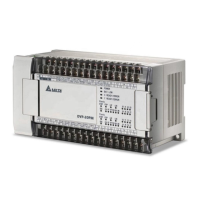9 Electronic Cam
D1832: Setting the number of times noncyclic electronic cam motion is repeated
Users can set the number of times noncyclic electronic cam motion is repeated by means of D1832.
If the value in D1832 is greater than H8000 (bit 15=1), there will be cyclic electronic cam motion. If
the value in D1832 is 0, noncyclic electronic cam motion will not be repeated. If the value in D1832
is 1, noncyclic electronic cam motion will be repeated once.
D1832=0
Start0 / PG0
Master position
Slave position
D1832=1
Slave position
Start0 / Pg0
Master position
D1833: Number of remaining pulses sent by the master axis of an electronic cam
If the number of pulses sent by the master axis of an electronic cam is not divisible by the number
of pulses per ccycle, users can divide the number that is left by setting D1833. If the value in D1832
is 4, and the value in D1833 is 2, one pulse will be added to the first cycle and the second cycle.
(Note: The value in D1833 can not be greater than the value in D1832.)
NNN
N+1 N+1
Slave position
Start0 / Pg0
Master position
D1834: Number of pulses sent by the master axis of the electronic cam before the electronic cam is
started
Users can delay the sending of pulses by the slave axis of a noncyclic electronic cam by setting
D1834. When the number of pulses sent by the master of a noncyclic electronic cam sends is equal
to the value in D1834, the slave axis of the noncyclic electronic cam sends pulses.
D1834=10
N
10
Slave position
Start0 / Pg0
Master position
D1834=50
N
50
Slave position
Start0 / Pg0
Master position
Selecting the start signal of noncyclic electronic cam
1. When M1746 is OFF, the start signal of noncyclic electronic cam will be START0; when M1746
is ON, PG0 will be the start signal of noncyclic electronic cam.
DVP-20PM Application Manual
9-17

